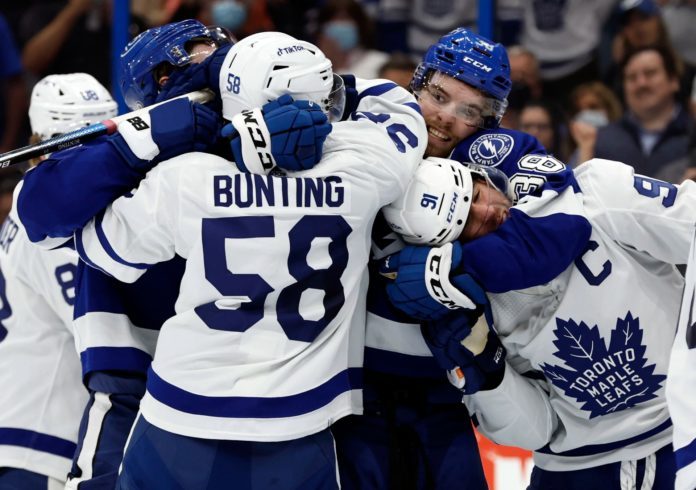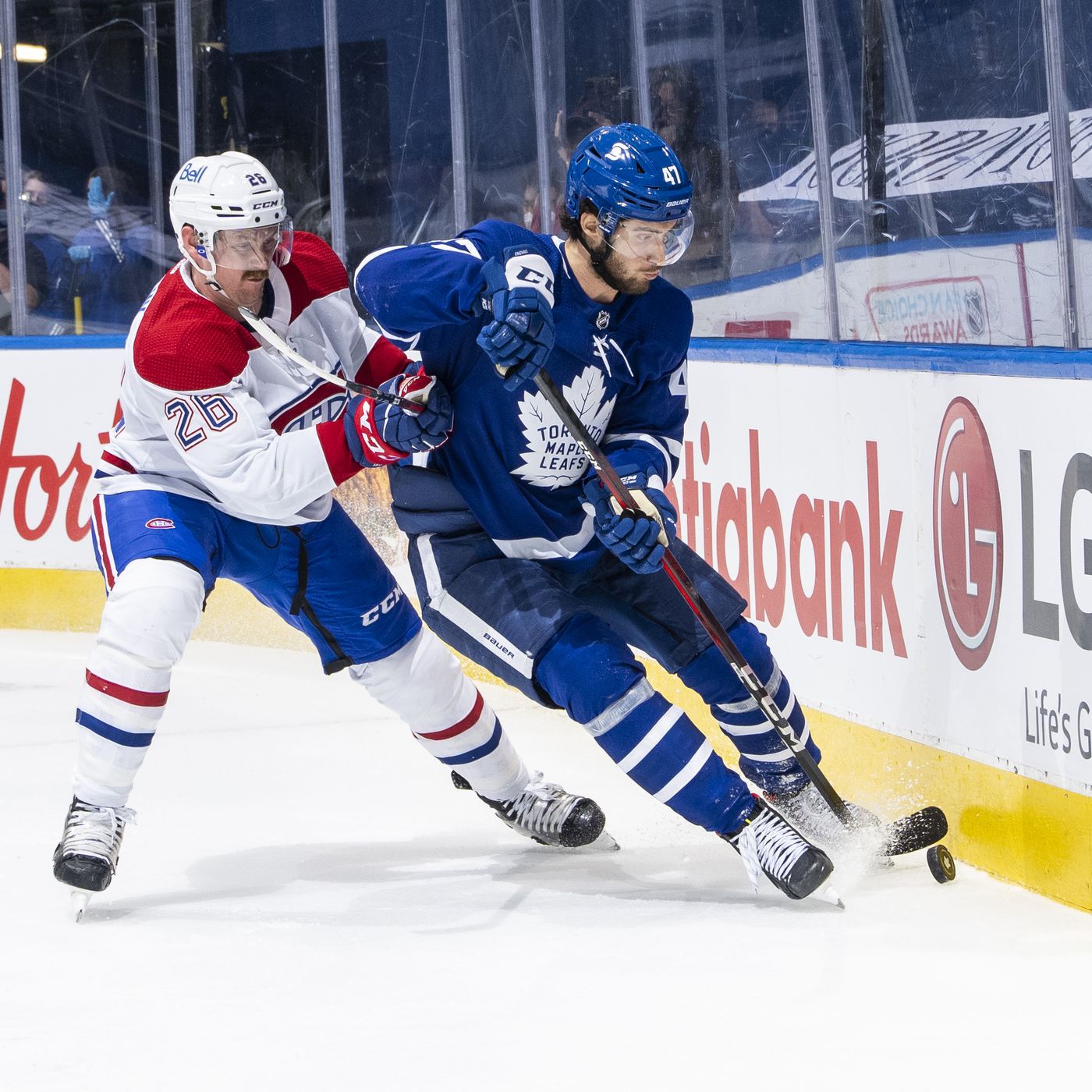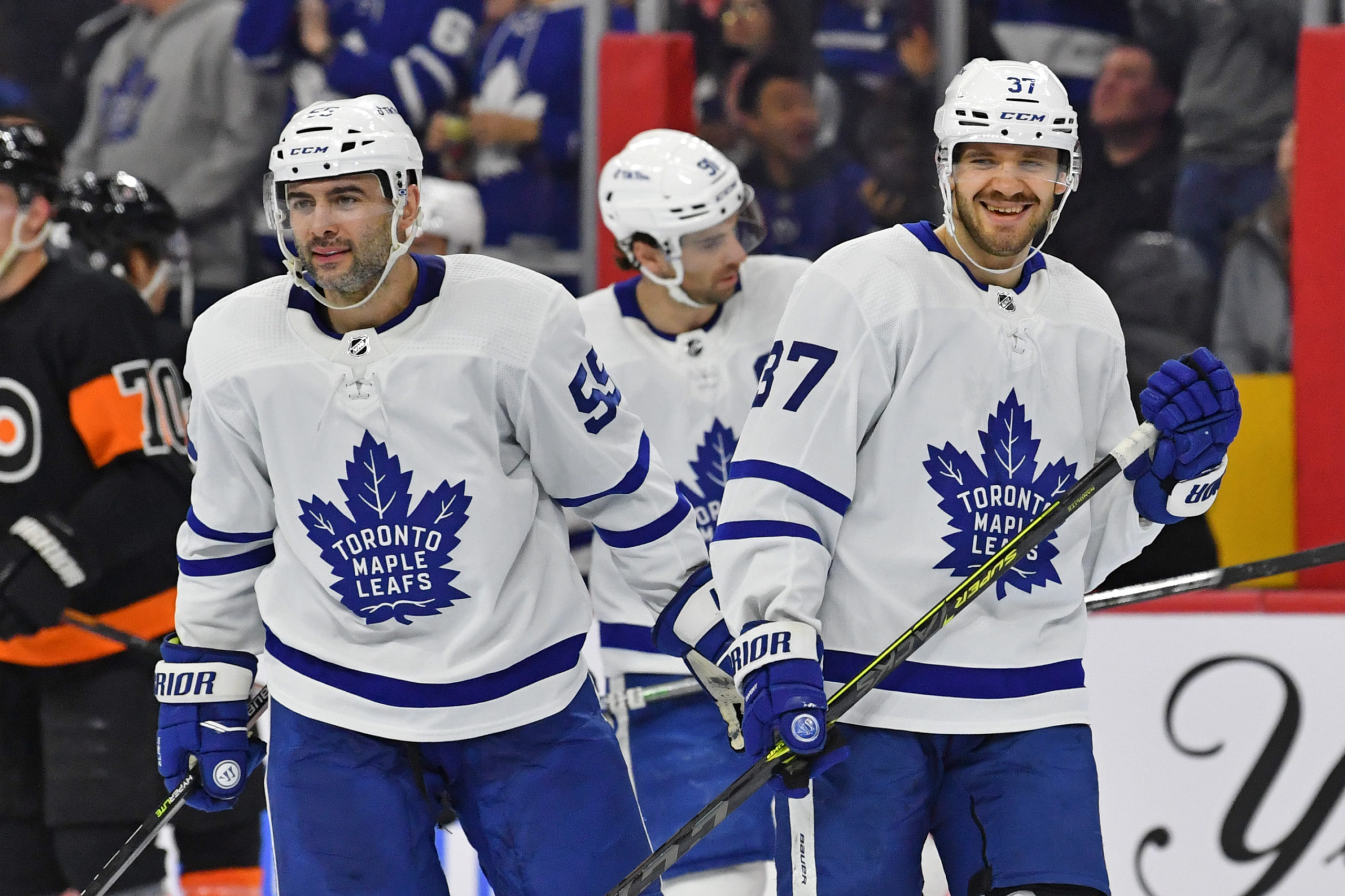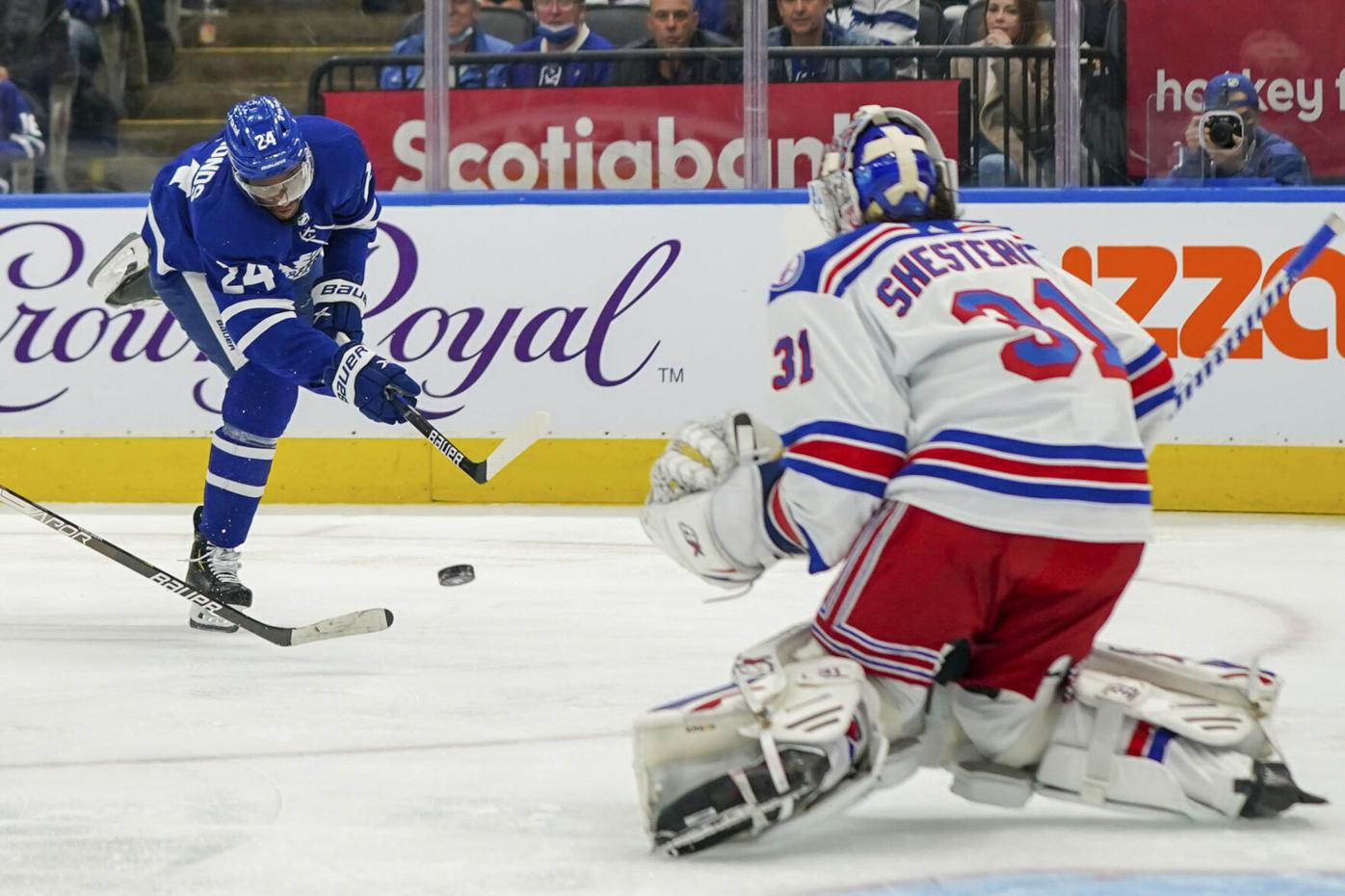
Over the last few seasons, Kyle Dubas and his management team have done a good job of navigating some notable pending-UFA contract negotiations by holding firm on internal salary limits – namely, their contract negotiations with Zach Hyman and Jack Campbell.
It didn’t even sound like they bothered much with Ilya Mikheyev, probably already knowing he was going to be priced out of their range (and $4.75 million over four years is not a contract they want on the books).
With Hyman, they did try extending the term to eight years to shave down the annual average value. It was a fair approach with a very good hockey player, but the dollars didn’t work for the other party. It’s unclear how far along talks progressed with Campbell, but he ended up earning good money over a lengthy term. Even with lesser players like Alex Galchenyuk and Nick Foligno, Dubas and Brandon Pridham held firm.
On the flip side, they signed Morgan Rielly and Jake Muzzin to big deals and lengthy terms.
Ultimately, they have to feel pretty good about many of those decisions. This brings us to Michael Bunting.
By now, we all know the story with Bunting. He arrived in Toronto on a bargain-bin contract, worked his way up the lineup, and ultimately found a home alongside the Leafs’ two best players. His 63 points ranked sixth on the team and earned him a nomination as a Calder finalist.
Fans – in this market especially – are understandably tired of these incessant conversations regarding the salary cap and contract negotiations. I can hear you sighing right now and asking me, “Why does this need to be talked about so early in the season?” These are all fair points, but this isn’t a deep dive into the team’s salary cap, Bunting’s comparables, and whether the numbers work.
For me, this is the reason it’s a question early in the season: The Leafs have an opportunity to really make sure they know what they have in this player before committing significant dollars to him long-term.
There might not be a more desirable left-wing job in the league right now than playing alongside Auston Matthews and Mitch Marner. One player is the best goal-scorer in the league. The other is an elite playmaker. Both players make things happen all over the ice.
This isn’t a case of playing with someone like, say, Phil Kessel, who struggled defensively and physically and is ideally paired with certain players to make up for those shortcomings. Matthews and Marner are complete, elite players.
It’s not to take anything away from Bunting – he has been a legitimate revelation – but there are a lot of players who could comfortably slot into that spot. They might not put up 60+ points as Bunting has, but Matthews and Marner will continue to eat regardless.
In some ways, it reminds me a little bit of Anson Carter and the Sedins back in 2005-06. Carter, a pretty good scorer in the league, joined the Canucks on a cheap contract and scored 33 goals alongside the twins. When it came time for a new contract, he held firm on his demands. The Canucks ultimately walked away, Carter went elsewhere for parts of two seasons, and the Sedins played with a revolving door of linemates alongside them as they ascended into superstars, eventually leading Vancouver to a Stanley Cup Finals appearance.
All of that is to say: The Leafs should really figure out what Bunting is without Matthews and Marner if they are even remotely entertaining paying him big dollars with term (or offering a similar structure to what they offered Hyman).
Hyman proved he could carry a line on his own in Toronto. Is Bunting able to? He played over 181 minutes at 5v5 last season without Matthews and Marner last season and was below water in every category – corsi, fenwick, expected goals, actual goals (nine for, 11 against).
Bunting also doesn’t penalty kill. When the Leafs are protecting leads, they often put someone else on the line to close out the game (like Alex Kerfoot, or recently, Zach Aston-Reese). And he plays on the second power-play unit. He’s been benched twice already this season as well.
Again, for a tight-to-the-cap team, how much can they really afford to pay a nice complementary player?
Early on in the season is a great time to find out. Try him on different lines knowing Matthews and Marner will be fine with other players (or maybe, in a twist, we learn that they aren’t, which would also be valuable to know). Keeping him on the top line all season and watching him collect points alongside two elite players before potentially offering him big dollars and term isn’t the best approach.
We are already seeing it with Alex Kerfoot when moved away from John Tavares and William Nylander. In a contract year, he’s going to produce less. Why not challenge Bunting and really find out what you have in the player before making any decisions moving forward?
Notes

-
Six games into the season, the Leafs haven’t particularly played their best hockey yet, but they are 4-2-0 with a .667 points percentage. To put it into perspective, Tampa Bay finished with a .671 points percentage last season. Washington was the final East wildcard team with a .610 points percentage. Nashville qualified with a .591 points percentage. If the Leafs don’t hit another gear at some point, there will be a reason for concern, but to hum along collecting points without playing their best is usually the sign of a strong team.
-
It came early, but the annual healthy scratch of Pierre Engvall arrived. Sheldon Keefe used to call out Engvall regularly – something even Jason Spezza made reference to last season. He missed most of training camp and has not looked like himself so far this season.
-
To Engvall’s credit, he has almost always responded well to healthy scratches. Certain players need the kick in the butt at times to spark their game. He seems to be one of them.
-
Nicolas Aube-Kubel might be another one of those players. It should be noted he was on waivers last season and was claimed by a really good Colorado team that was way down the waiver priority list. He ultimately responded with a career-high 11-goal, 22-point season.
-
In Philly, Aube-Kubel also spent some time as a healthy scratch. Again, certain players need a shorter rope. I thought he would have come out with more fire to start the season, but we’ll see how he responds.
-
I can’t put my finger on it, but Auston Matthews’ shot doesn’t seem to have the same zip it usually does. He has one goal through six games, and it was a tip. It’s not like he isn’t shooting – he’s averaging four shots per game – but he hasn’t ripped too many with his patented ‘wide stance, curl the puck in’ snappers.
Last season, he scored one goal in October, but it was understandable and fair to expect it as he was coming off of wrist surgery and missed the preseason. It’s far too early to be worried, but I’d be remiss if I didn’t note that his shot does look a little bit off.
-
Quite a role change so far for Alex Kerfoot this season. Last season, he played all of nine minutes and 10 seconds on the power play. So far this season, he has played 10 minutes and 15 seconds there as a firm member of the second unit (and has a power play goal to boot).
-
He’s also playing center pretty well full-time so far this season (against Arizona, he moved up to L1 left wing, but that was more of an indictment of Michael Bunting’s play). Even on the penalty kill, he’s averaging 21 seconds more per game there. The coaching staff is using him everywhere and asking a lot of him away from John Tavares and William Nylander.
Quotes

“Speaks a lot to Mo’s character and not surprising, the way he carries himself and leads our group. After that, we stayed calm and composed as the temperature of the game went up.”
– John Tavares on Morgan Rielly stepping up in response to a hit on Nick Robertson
Over the years, Morgan Rielly has consistently responded when a teammate has been targeted. It is not a coincidence that he is held in such high regard by his teammates. Last season, he went after Nikita Zadorov — who is a beast — after he crushed Ondrej Kase. It doesn’t matter who it is (or how big he is), Rielly responds.
“I’m here for the boys and I will always be here for these guys. I love these guys. From day one, I was accepted immediately. When that happens and you have such group camaraderie, for me late in my career, it’s something that you cherish.”
– Wayne Simmonds after being inserted back into the lineup
It’s hard not to love Wayne Simmonds and hope for the best for him. As a fan, you can’t ask for much more. That was a hell of a moment for him to return to the lineup after passing through waivers and pick up the game-winning assist.
“I used some of the wrong words to describe what I was trying to describe. The difference in the game was that we weren’t able to produce, whether on the power play or at five-on-five. That is really the difference with all of the puck time we had.
By no means was I meaning anything beyond that, which is what I wanted them to be sure of. As it turned out, they didn’t know what I was talking about, which is a good thing.”
– Sheldon Keefe explaining himself after calling out the top players for their performance against Arizona
This was a story all week, and while you can either read between the lines on the team dynamic or argue it’s a lot of hoopla about nothing, what stood out to me is that the Leafs brought it on themselves.
It didn’t have to be a story. Sure, the media was going to follow up on Sheldon Keefe’s comments a few days later, but it wasn’t exactly a story people in the market were waiting with bated breath to hear about. The attempt at clarification absolutely made it worse.
If Keefe stuck to it with a simple answer of, “Yeah, we need to better, and the guys know it,” the players aren’t upset, the fans aren’t upset, and the media drops it immediately. Instead, it was days of explaining the message, the player reaction, and the reaction to the reaction.
You can chalk it up to the media insanity in this market, but when the coach is publicly wavering, it’s going to be a topic of conversation, especially while a contending team works through some early-season kinks. It would be a discussion point in any major market with the way it played out. They simply have to handle that situation better.
Tweets of the Week

People make fun of takes like this but Glendening absolutely should’ve eaten shit even if it meant taking a penalty. It’s important to have your teammates’ backs and for them to know and trust that. Ultimately they are human beings and we are emotional creatures https://t.co/MTVo1GJJ3l
— virtue signaller (@jakebeleafs) October 21, 2022
It seems to be an annual conversation now. This is a team sport played by ultra-competitive human beings with real emotions. Teammates need to have one other’s backs.
Mark Giordano is the oldest player to play in the league so far this season and is an important contributor to the team. Teammates should be particularly quick to jump in when he is crumpled into the end boards instead of standing around.
If you rewatch the clip, Jamie Benn actually races in because he thinks a scuffle is going to break out, and he nearly laughs out loud when he realizes no response is coming.
No, we don’t need to hear about going to a power play late in game five of 82 in a regular season that is a borderline formality at this point for this team.
ran some numbers for tonight's game pic.twitter.com/tCutn5R1Cs
— Acting the Fulemin (@ATFulemin) October 17, 2022
As funny as this is, the Leafs do need to address the recurring theme here. The bottom teams in the league know they can’t keep up with the Leafs’ talent and play the Leafs pretty well the exact same way: They rarely send multiple forecheckers, retreat through the neutral zone, pack the house in their end, allow the Leafs to handle the puck around the perimeter without much pressure, and essentially rope-a-dope the game while hoping to pounce on a few mistakes and/or power play opportunities.
As much as it has become a running joke, it’s also important that the Leafs learn how to win these games. Columbus largely followed this playbook against them in the playoffs, as did Montreal. Tampa didn’t, but in Game 7 with Brayden Point injured, we did see a version of this style of play.
Not everything needs to be a pretty play. Sometimes it starts with getting bodies and pucks to the net. It’s tempting to shrug these games off against bad teams, but they would be important to me if I were the coach knowing it’s generally how they’ve been losing at springtime.
Börje Salming — who can no longer speak due to the advancement of his ALS diagnosis — shares a message with his fans. Watch the full interview with Börje and his wife Pia on https://t.co/XalW2j5jjs
(🎥: @Expressen) pic.twitter.com/k2agzUFWZw
— TSN (@TSN_Sports) October 18, 2022
Incredibly sad to see. Sending Borje well wishes and hoping for the best.
Five Things I Think I’d Do

1. At this point in the season, I think there is a collection of forwards I would be rotating in and out until a few of them give the coaching staff no choice but to play them every night. With the ability to call up players at the moment, the group would include Zach Aston-Reese, Nicolas Aube-Kubel, Pierre Engvall, Wayne Simmonds, and Kyle Clifford.
2. I think I would put Pierre Engvall back in now and hope the healthy scratch serves as a wake-up call. Last season, I liked him best playing alongside David Kampf (and I also think he helped Kampf with his puck-carrying skills). I’d reunite them on the fourth line and keep Wayne Simmonds in on the fourth-line right-wing spot alongside them.
3. I do think I’d be pretty close to shaking up the top six. Yes, the John Tavares – William Nylander combo has been good, but the Auston Matthews – Mitch Marner line hasn’t found its groove yet. At times, things get stale. We seem to talk about it every season, but why do they need to keep these pairings locked in for the full 82 games? When it plateaus, mix them up and get everyone on their toes.
4. While PP1 has generally been fine, I think there’s enough talent on PP2 to start them on occasion, especially when PP1 isn’t scoring. Against Dallas, they went two for eight (one goal was scored seconds after a power play expired) and the two goals were scored by PP2. PP2 started one power play, it didn’t go perfectly, and PP1 kept getting trotted out, no questions asked. In the end, the top-unit forwards each played over 10 minutes on the power play followed by Kerfoot’s 3:09 (he scored the lone power play goal). No other forwards played over three minutes.
I understand how the averages work over the course of a season. If you keep the big unit together and continue putting them out there, they will score as they did in Winnipeg. The Leafs’ overall PP percentage is strong right now, too.
In-game, though, sometimes you have to ride the hot hand. A unit featuring Nick Robertson’s shot, Bunting’s craftiness in the slot, and one of Sandin/Giordano running the point is far from pitiful. Reward good play.
5. I would start Erik Källgren on Saturday against the Kings. The Leafs have a back-to-back on Saturday and Sunday, and instead of starting Ilya Samsonov on Thursday and Saturday, I’d give him the extra day’s rest while also giving Kallgren a better chance to win a game playing in front of a rested team on Saturday instead of a tired team Sunday.
All of that said, Samsonov has been good in the net, so I’d ride the hot hand as much as possible.





























![New Leaf Anthony Stolarz on the opportunity in Toronto: “In Florida, I knew my role as a backup… Now, [Joseph Woll] and I are competing for starts… As a goalie, that’s all you can ask for” Anthony Stolarz, Stanley Cup win, now Maple Leaf](https://mapleleafshotstove.com/wp-content/uploads/2024/07/anthony-stolarz-sc-100x70.jpg)
